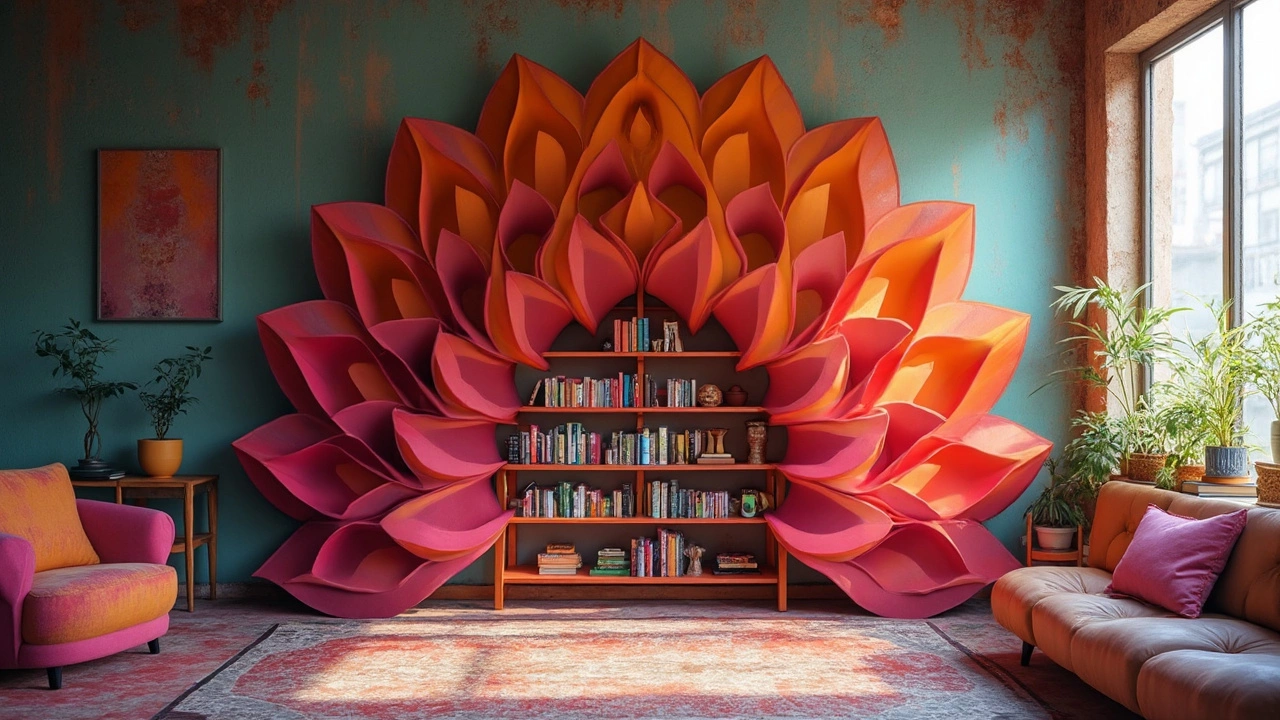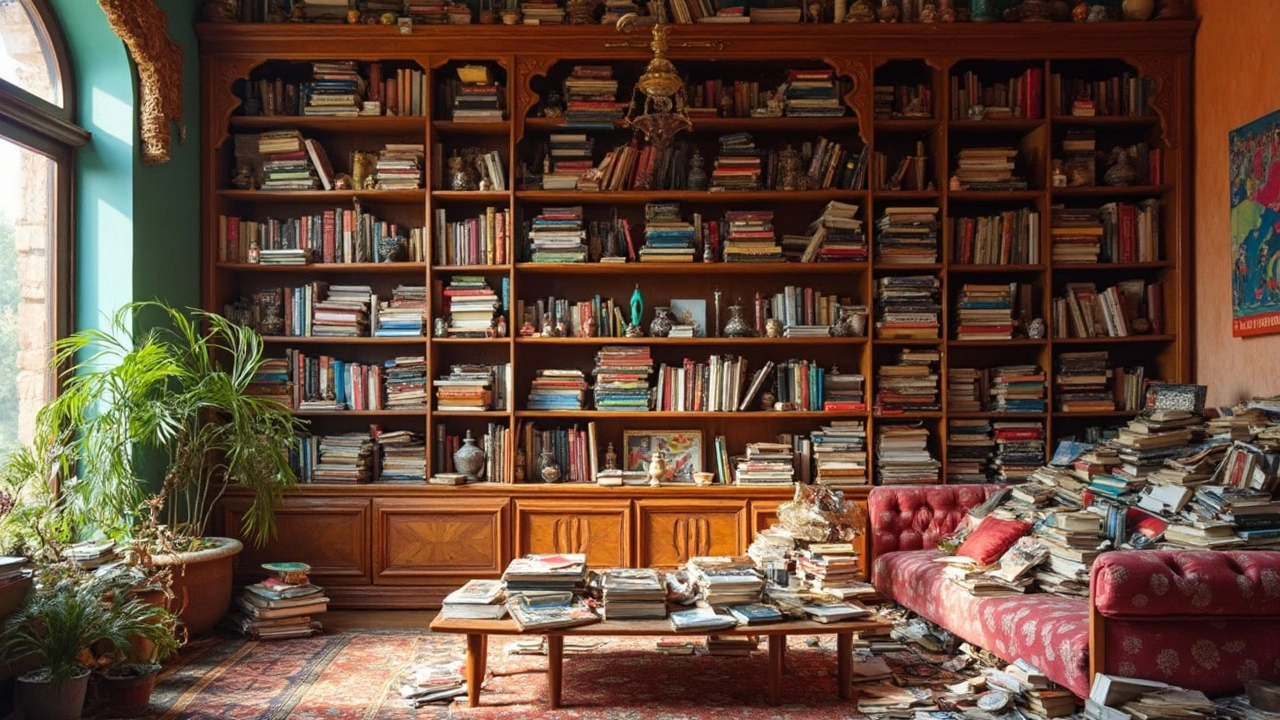Bookshelves are the unsung heroes of avid readers and proud book collectors. But guess what? They come with their set of challenges too. One major gripe is their appetite for space. If you're living in a tiny apartment, you know what I mean. Those towering shelves eat square footage, making small spaces feel even more cramped.
Then there's the upkeep. Dust gathers, and without regular cleaning, they can look shabby in no time. Plus, if you're not the organized type, a bookshelf can quickly turn into a jumbled mess. Admit it—how many times have you spotted books lying horizontally just because you ran out of vertical space?
Bookshelves can also put a cramp in your design style. Ever tried rearranging your living room only to realize the bookshelf isn’t short enough to fit under the window? It's like a game of Tetris with furniture. And don't even get me started on stability issues. They may tip if overloaded or not well-anchored, becoming potential hazards, especially in homes with kids or pets.
- Space Consumption
- Maintenance Hassles
- Clutter and Organization
- Design Limitations
- Safety Concerns
- Alternatives to Traditional Bookshelves
Space Consumption
Alright, let's chat about the elephant in the room: space consumption when it comes to bookshelves. Everyone loves the idea of a home library, but these towering bookcases can hog valuable real estate, which is a bummer if you're living in a cozy space.
For starters, standard bookshelves are typically around seven feet tall and two to three feet wide. That’s a whole lot of wall space being devoured by one piece of furniture. In a small studio or even a moderate-sized room, that can mean sacrificing other potential pieces of furniture or just plain old living space.
Now, let's throw some numbers in. Did you know that the average American living room is about 340 square feet? Dedicate a five-foot-wide section to a bookshelf, and you're looking at about 1.5% of your living space just being storage—a fancy but immobile piece at that.
Some folks consider built-in shelves to circumvent these issues, but even they come with their own set of limitations. Built-ins can make a room look smaller because they're, well, built-in! They’re permanent and can make the room's design layout feel fixed and unchangeable.
Storage solutions are crucial in today's world, where every square foot matters, especially with the trend moving towards downsizing and minimalist living. Think tiny houses, or those apartments inspired by Japanese efficiency. They might require you to think outside the box when it comes to storing your beloved books.
If you're struggling with space, it might be worth exploring multi-functional furniture. How about a storage ottoman for paperbacks or under-the-bed storage boxes? These can help keep your space tidy and leave room for other necessities.
Maintenance Hassles
Keeping bookshelves in top shape involves more than just choosing the right design. Those beautiful rows of books come with the responsibility of regular upkeep. Dust is the archenemy here. It doesn't take long for it to settle on those horizontal surfaces, and over time, it can dull even the most stunning books. But dusting isn't the only chore.
Dusting and Cleaning
For dusting, using a microfiber cloth can work wonders, as it traps dust instead of spreading it around. Aim to dust your bookcases weekly to prevent buildup. If you've got an enormous collection, divide your cleaning efforts into sections, tackling one shelf at a time to avoid feeling overwhelmed.
Proper Book Arrangement
How you organize your books directly affects maintenance. Tight arrangements not only look neat but also minimize dust falling between books. A useful trick is to leave a little space at the back of each shelf for air circulation, which can help prevent mustiness.
Addressing Wear and Tear
Bookshelves aren't immune to signs of wear. Shelves might sag over time if overloaded. Rearrange the shelves and alternate heavy books with lighter items to distribute weight evenly. Plus, occasional tightening of screws is recommended to keep everything firm and stable.
Insect Prevention
Bookshelves can attract bugs if left in humid or dark areas, especially if you love those old, vintage collections. Cedar blocks placed on shelves are a natural deterrent. Essential oils like lavender or peppermint also repel insects, leaving a pleasant aroma behind.
Think of maintenance as part of the book-loving journey. Sure, it's a bit of effort, but it keeps your treasured collection looking its best!
Clutter and Organization
When it comes to bookshelves, staying organized can be quite the challenge. If you're not careful, they can quickly become a black hole of clutter. It's almost like they have a magnet for random stuff—an old receipt here, a mismatched sock there. Before you know it, your precious bookcases look more like a yard sale than a well-ordered library.
So, how do you keep your bookshelves neat and tidy? First things first: regular clean-outs. Set aside time every few months to reassess what's on those shelves. Do you need everything there? Probably not. Decluttering is a cathartic process, trust me.
Once you've dealt with the unnecessary stuff, it's time to organize. Consider categorizing books by genre, author, or even color—whatever helps you find them easily. There’s this classic tip: put the most-read books at eye level. Makes life so much easier.
Storage Solutions
Need more tips? Think outside the box—er, bookshelf. Add baskets or bins for odds and ends. They're lifesavers for smaller items that don’t quite fit anywhere else. Plus, they add a nice touch of style to your home design.
Design Tips
Finally, use accessories wisely. A strategically placed bookend or a small indoor plant can break up the monotony and add a bit of flair. But remember: moderation is key. Too many accessories can defeat the purpose and bring you back to square one with clutter.
Now, if you happen to be someone who loves data, an interesting fact for you: according to a 2023 home organization survey, about 75% of people feel overwhelmed by the clutter on their bookshelves. So if you’ve been feeling stressed, know you’re not alone.

Design Limitations
When it comes to integrating bookshelves into your home, it's not always a piece of cake. One of the first issues you'll run into is their sheer size. These bookcases often dictate where you can place other pieces of furniture, limiting your creativity in arranging your living space. Ever tried fitting a bookshelf into a room with a sloped ceiling? It's not happening without some compromises.
Fixed and Rigid Structures
Typical bookshelves come in fixed dimensions, and once they're assembled, that's pretty much it. If you decide to switch things up, you'll find they're not exactly easy to move around. Unlike modular furniture, they're not designed with change in mind. If only they came with wheels for easy room redesigns!Besides, bookshelves often stick to traditional designs, prioritizing function over flair. Sure, wooden shelves are classic, but they don't always blend with every décor style, especially if you're going for something modern or eclectic. A metal or glass shelf could jazz things up, but those options are often not sturdy enough for heavy loads.
Customization Challenges
If you're thinking about customizing a bookshelf to better fit your space, be ready for a financial sting. Tailored solutions often come with higher costs, with intricate designs or materials like metal and glass easily spiking prices. And let's be real, not everyone has the budget for a bespoke, fancy bookshelf, even if it means solving those pesky design limitations.In summary, while bookshelves are wonderful for stashing all those beloved reads, they're not always the most flexible option for home décor. They require a bit of foresight and might not be the perfect fit for every room setup, especially if the room is on the smaller side or has an unusual layout.
Safety Concerns
When we think about bookshelves, safety might not be the first thing that pops into our head, but it definitely should be. Heavy books and wobbly shelves can be a recipe for disaster. Especially if you have kids running around or curious pets, unsecured shelves can be downright hazardous.
Tip Hazards
Ever heard of tip-over accidents? They happen more often than you think. Shelves that aren't anchored to the wall can easily tip over with the slightest nudge or if they’re top-heavy. That's why securing them is non-negotiable, especially in homes with little explorers who love to climb.
Weight Distribution
Not all bookcases are created equal. Some have weight limits that, if ignored, could lead to collapsing shelves. Always check manufacturer guidelines on weight limits and arrange heavier books at the bottom to keep that center of gravity low.
Here's a tip: use brackets or straps to anchor your shelves to the wall. It's a small step that can prevent a big accident.
Material Concerns
Then there's the material aspect. Cheap composite woods might not hold up well over time, leading to potential breakage. Plus, watch out for any sharp edges that could lead to unintended scrapes and bruises.
| Safety Tip | Description |
|---|---|
| Anchor Shelves | Use brackets or straps to secure shelves to the wall. |
| Check Weight Limits | Ensure bookshelves aren't overloaded to prevent collapsing. |
| Inspect Materials | Opt for sturdy materials and watch out for sharp edges. |
By keeping these safety aspects in check, you can enjoy your bookshelf without the added worry. After all, it's there to showcase your favorite reads, not to be a cause for concern.
Alternatives to Traditional Bookshelves
If you're tired of the usual bookshelves taking up your room, consider these alternatives to spice up your storage game. Whether you're looking for more space or just a fresh look, there's something for everyone.
Floating Shelves
Floating shelves are your best friends if you're aiming for a modern and airy vibe. They free up floor space and add a sleek touch to any room. You can stagger them for an artsy effect or use them to create a continuous line. Plus, they can fit in nooks or above desks where traditional bookcases struggle to go.
"Floating shelves are the minimalist's answer to book storage," says interior designer Jane Smith. "They provide functionality without the bulk."
Built-in Shelving
If you own your space and plan to stay a while, built-in shelving can be a great investment. It seamlessly integrates into the room, maximizing every inch of available space. These shelves can be tailored to your specific needs, and the best part? They add serious value to your property.
Wall-mounted Book Ledges
Want quick access to your current reads? Book ledges keep your favorite titles at arm's reach. They differ from floating shelves by offering just enough space for books to lean against the wall, reducing the chance of a chaotic shelf.
Under-bed Storage
Perfect for studio apartments, under-bed storage lets you stash books neatly out of sight. Use flat bins or custom drawers for a tidy look. Just be careful not to turn it into a literary graveyard!
Multipurpose Furniture
Think outside the bookcase! Ottomans with storage, coffee tables with built-in space, or benches with hidden compartments can all pull double duty. You'll not only store books but also optimize space.
| Option | Space Efficiency | Cost |
|---|---|---|
| Floating Shelves | High | Medium |
| Built-in Shelving | Very High | High |
| Book Ledges | Medium | Low |
| Under-bed Storage | High | Low |
| Multipurpose Furniture | High | Varies |
These alternatives ensure that your book collection stays organized and accessible without sacrificing style or space. Don't be bound by tradition; explore these options and find what's right for your living space.

